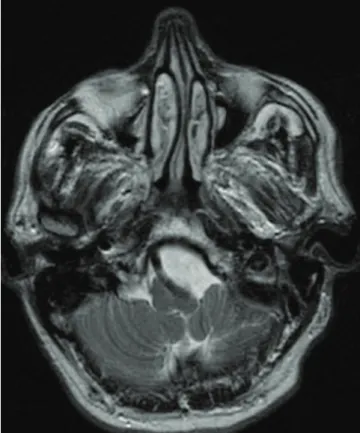384
LETTERS
he occurrence of headache triggered by bath (bath-related headache – BRH –) is rare. he irst reference in the literature is of three middle-aged Japanese patients who, in 1992, developed symptoms of abrupt headache onset, of explosive and violent characteristic, caused by drop of hot water over the body in the shower which persisted for several weeks and resolved1.
All the cases reported in the literature occurred in Asian populations1,2, and there is a unique report on a Spanish woman3.
We present a case of a Brazilian patient with no Asian ancestry. Fifty-one-year-old woman, born and resident in Recife, Brazil, with no previous episodes of headache, had nicotine dependence and started varenicline, that was interrupted 30 days after two weeks of use.
he irst episode occurred during the bath: sudden and very intense pain reaching the maximum power from the beginning. She described it as if something was to break the skull, and adjectives of “volcanic” and “cosmic” pain were ex-pressed. She localized it on the “top of the head”, bilaterally at the frontoparietal region. It lasted about 30 minutes slowly regressing, but persisting with mild intensity during the rest of the day. he response to analgesics was poor. Clinical exam was normal. MRI and arteriography ruled out the possibility of subarachnoid hemorrhage.
She evolved with daily crises, triggered by the water as it contacts the head. She began to avoid showering, fearing re-currence. Last episode occurred approximately 15 days after onset and, to date, she had no further crisis.
1. Negoro K, Morimatsu M, Ikuta N, Nogaki H. Benign hot bath-related headache. Headache 2000;40:173-175.
2. Wang SJ, Fuh JL, Wu ZA, Chen SP, Lirng JF. Bath-related thunderclap headache: a study of 21 consecutive patients. Cephalalgia 2008;28:524-530.
3. Rossi P, Nappi G. Bath-related headache: the first European case. Cephalalgia 2006;26:1485-1486.
4. Solomon S, Dodick DW. Bathing headache: a variant of idiopathic thunderclap headache. Cephalalgia 2003;23:853.
5. Nakamura M, Oshima A, Fujimoto Y, Maruyama N, Ishibashi T, Reeves KR. Efficacy and tolerability of varenicline, an alpha4beta2 nicotinic acetylcholine receptor partial agonist, in a 12-week, randomized, placebo-controlled, dose-response study with 40-week follow-up for smoking cessation in Japanese smokers. Clin Ther 2007;29:1040-1056.
References
Medulla compression caused by
vertebrobasilar dolichoectasia
Compressão medular causada por dolicoectasia vertebrobasilar
Pedro Enrique Jiménez Caballero1, Ignacio Casado Naranjo2
1Facultativo Especialista en Neurología, Departamento de Neurología, Hospital San Pedro de Alcántara, Espanha; 2Jefe de Sección, Departamento de Neurología, Hospital San Pedro de Alcántara, Espanha.
Correspondence: Pedro Enrique Jiménez Caballero; Departamento de Neurología; Hospiral San Pedro de Alcántara; Avenida Pablo Naranjo s/n; 10003 Cáceres - Espanha; E-mail: pjimenez1010j@yahoo.es
Conflict of interest: There is no conflict of interest to declare.
Received 10 November 2011; Received in final form 09 December 2011; Accepted 16 December 2011
he contrast between the nature of an excruciating pain and the triggering of a so routine and trivial act is at least in-triguing. he physicians themselves, facing this unusual situa-tion and the picturesque character of the trigger, may tend to underestimate the condition and minimize it to a mere psy-chogenic conditioning factor.
It is assumed that BRH is a variant of idiopathic thun-derclap headache, which may also have as a trigger a va-riety of factors, such as the Valsalva maneuver, sexual intercourse or strenuous exercise4. Etiopathogenic
hy-potheses involve excessive stimulation of temperature receptors in the skin and scalp and exaggerated auto-nomic neurovascular reflex, resulting in reversible cere-bral vasoconstriction4.
he pathogenic role of varenicline as a partial nicotinic cholinergic agonist is questioned. his is a new drug that in-cludes in its side efects proile the onset of mild to moderate headache in 10.3%5. Although the symptoms occurred one
month after it was discontinued, its participation cannot be completely rule out, since central nicotinic receptors have a role in brain vasoregulation.
he occurrence of BRH only in the Asian population was in-triguing, but the report of this case and another one alike in this west part of the world3 indicates that ethnic factors perhaps
385
Arq Neuropsiquiatr 2012;70(5):381-385
Vertebrobasilar dolichoectasia (VBD) is a distinct arteri-opathy characterized by elongation and dilatation of basilar and vertebral arteries. Prevalence is estimated to be 0.05%1.
VBD may be asymptomatic or associated with clinical manifestations, such as posterior circulation stroke, intracra-nial bleeding, craintracra-nial nerve disorders, compression of brain-stem or obstructive hydrocephalus2. Medullary compression
by the vertebral artery (VA) is a little known clinical entity in the medical literature.
Fig 1. Brain MRI (T2-weighted axial section) revealing a dolichoectactic left-sided vertebral artery with impingement of the left ventrolateral medulla surface.
Fig 2. Magnetic resonance angiography showing left vertebral artery with enlargement diameter and tortuous journey.
1. Caplan LR. Dilatative arteriopathy (dolichoectasia): what is known and not known. Ann Neurol 2005;57:469-471.
2. Passero SG, Rossi S. Natural history of vertebrobasilar dolichoectasia. Neurology 2008;70:66-72.
3. Savitz SI, Ronthal M, Caplan LR. Vertebral artery compression of the medulla. Arch Neurol 2006;63:234-241.
4. Gutierrez J, Sacco RL, Wright CB. Dolichoectasia - an evolving arterial disease. Neurology 2011;7:41-50.
5. Gupta D, George UB, Pandian JD. Vertebrobasilar dolichoectasia and a tale of two brothers. Neurol India 2010;58:810-812.
References
CASES REPORT
